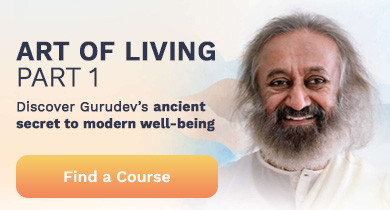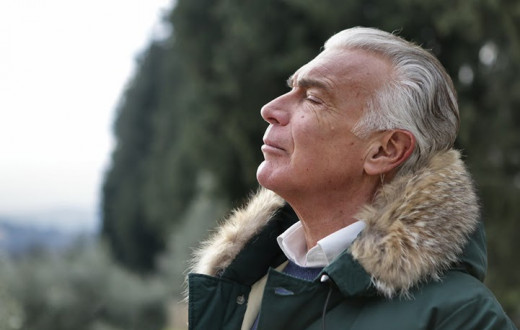By Gurudev Sri Sri Ravi Shankar┃Updated on : June 09, 2021
Yoga and meditation are ever-growing in popularity, but that also means that the original message can be lost. Learn the true meaning of yoga here!
Taken from a talk by Gurudev Sri Sri Ravi Shankar on International Yoga Day 2016, the following reveals reflections on yoga in its truest sense, covering guidance on deep meditation, identifying a yogi, the different aspects of yoga practice, and much more.
This article consists of the second part of the speech. The first part is contained in another one of this blog’s posts, under the title, ‘What is Yoga? Reflections on the True Spirit of Yoga by Gurudev Sri Sri Ravi Shankar on International Yoga Day.’
Multi-fold benefits of yoga
Today, knowledge of yoga and its practices has been successful in bringing about a great transformation in the lives of thousands and thousands of people everywhere. Yoga is not just a theoretical principle; it’s a practical and holistic approach that surely brings a positive transformation by regular sincere practice. One needs to practice it regularly.
One of the sayings in Sanskrit is, “Yoga chitta-vritti nirodhaha” (Meaning: Yoga helps to arrest and remove the modulations or distortions of the mind). Now, how can yoga help to transform the mind? Through Abhyasa (regular practice) and Vairagya (cultivating dispassion). Both are necessary. Regular practice of yoga helps to cleanse and uplift the inner self. In simpler words, I would say - Yoga brings harmony in our environment. It is the alignment of the individual with Universal Spirit.
If you observe your breath, you will find there is a lot of unsteadiness. You may ask me how and why is this so. The breath has an impact on the mind, and the mind has an impact on the breath. Actually, the breath is the connecting link between the body and the mind. Every emotion has a corresponding rhythm in the breath, and an impact on the body as well.
A quiver-free breath is the sign of enlightenment; it’s a sign of a calm and pleasant state of mind. A disease-free body, a violence-free society, a confusion-free mind, an inhibition-free intellect, a trauma-free memory, a sorrow-free soul, and a quiver-free breath are the impacts that yoga can make on your life.
If you claim that you are a yogi, then you should have an undying smile on your face. I would say, that is the sign of a yogi. Yoga makes your emotions softer and more peaceful, and you blossom in your emotions. It brings freedom in your expression and your thought patterns. These are the real signs of yoga. It isn’t just the flexibility of the body. Of course, that too is a part of yoga. The body becomes flexible, and the mind grows in faith and conviction. If all this happens, know that it’s because of the gift of yoga, and consider yourself a yogi.
As natural as a baby
You may have observed that a child from birth to three years of age is able to perform all the yoga asanas very comfortably. At that age, the child is able to do pranayamas also, and does everything in a meditative state, even walking. If you carefully observe a child from the time it’s three months old till it grows to three years of age, I tell you, you need not search for another yoga teacher anywhere. Children can teach you yoga so perfectly.
In fact, we’ve all grown up doing yoga. When we stop doing yoga, the mind stops blossoming and goes through different distortions. So, to free the mind from negativity and distortion, we need to take refuge in yoga. To rid our society of social ills, we need the help of yoga; be it addiction, intoxication, etc.
Many of our youth are struggling with the problem of addiction. I tell you if they choose to take up the path of yoga instead, a different intoxication and energy surges from within that uplifts and takes them to a higher place. I often tell the youth that once you come to me, I shall provide you with the highest intoxicant, before which every other intoxicant will fail.
Yoga is a kind of intoxication too, but it uplifts you and elevates you to greater progress. It prevents your downfall into ignorance and negativity. It brings a wave of harmony and belongingness throughout society. Such is the greatness of yoga.
Two approaches
I would once again say that yoga does not simply mean doing physical exercises. Without the practices of pranayama and meditation, the experience of yoga is incomplete. Yoga has two approaches: anuloma and viloma.
Anuloma means the practices of yoga asanas, pranayama, meditation, yama (restraint through self-control), niyama (discipline), dharana (to steady the mind’s attention for meditation), and samadhi (state of non-duality and oneness with consciousness). Another approach, viloma, is when you first get a glimpse of samadhi and a slight experience of it, then having dharana, meditation, self-control, and discipline follows naturally and effortlessly.
Embrace yoga’s totality
We have often seen that when people who have violent tendencies or engage in violence meditate for some time, then they drop those violent tendencies and do other yoga practices more frequently.
Many people think of the eight limbs of yoga as a stepwise process to go level by level. They think that one has to strive to become proficient in one level before ascending to the next. This is not really so. I would say that all these eight limbs or aspects of yoga are woven together and happen simultaneously. When a child is conceived in the womb, then all its organs are formed together. It isn’t that first the feet are formed and then the arms take shape. No, it isn’t so.
All the limbs and organs develop together. This is why we must take all these eight aspects, or limbs of yoga, together at every step. Only then can we experience the fullness and totality of yoga, and bring about an extraordinary transformation.
Stretching beyond boundaries
See, movement stretched is dance. When you stretch your body in rhythm, then it’s a dance, isn’t it? Sound stretched is music. If we stretch the 'aa-' sound, then it becomes musical. Mind stretched is meditation.
Life stretched is celebration. When you think of your life in a limited way and only worry about a few people like, “Oh! What about my family?” or “What about my things?” then life isn’t stretched. But when life is stretched, you include your family, friends, entire community, and nation. Then life becomes a celebration. That’s what service is all about. Do you get what I am saying?
See, when you do yoga, just put everything aside – whether it’s your small problems, big issues, politics, social status, rich or poor, etc. Just put everything aside. I would say, yoga is one such area that should not be politicized or brought under the realm of politics. Do not drag something as universal as yoga into caste, religion, race, or geographical boundaries.
Yoga is above religion and community; it’s above social status. In the dimension of yoga, everyone is equal and the same: whether they are rich or poor, educated or uneducated. So can we keep this one field (yoga) away from every prejudice and influence?
Three golden rules
Now, there are three golden rules for meditation:
- The first is to be Achaah--meaning that during meditation, have the feeling, 'I don’t want or desire anything. For the next 10-15 minutes while I meditate, I do not want anything.’ Can you all say this? After 10-15 minutes of meditation, you can surely get back to what you were doing. So this is the first rule for meditation.
- The second rule is to be Aprayatna--meaning that for the next 10-15 minutes, just think, 'I shall do nothing, not make any effort.’ You need not chant, you need not concentrate or strain the mind to focus on something. You have to do absolutely nothing.
- The third rule for meditation is Akinchana--that’s to realize that 'I’m nothing.’ Drop everything, do not think 'I’m very knowledgeable, I’m a yogi; I’m a sinner, I’m a very noble person; I’m very great, I’m very insignificant; I’m very intelligent, I’m a third-rated fool,’ etc. Having either of the two dharanas will be detrimental to yoga and meditation. If we just bear these three principles in mind for the next 10-15 minutes for meditation, then we’ll be able to go deep into meditation. Will you all do this?
If you missed reading part 1 of this article, click here to read it.
We’d like to invite you to learn about SKY Breath Meditation, also known as Sudarshan Kriya, cognized by Gurudev Sri Sri Ravi Shankar. Click here to pick a day and time that works for you.






























